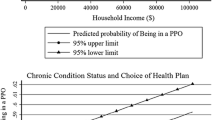Abstract
A 10% household sample of high- and low-income census tracts was interviewed to assess the extent of doctor shopping. In 632 households studied, 53% of high socioeconomic status and 51% of low socioeconomic status families had shopped for or changed doctors of their own volition. During the previous year, 4% of each socioeconomic group had consulted more than one doctor without referral for the same episode of illness. Shoppers could be distinguished from non-shoppers—shoppers were younger, were better informed about medical specialties, were less self-reliant, more hypochondriacal, expressed less hostility toward physicians, and had less positive attitudes toward the medical care system. The differences between shoppers and non-shoppers were generally similar for both high and low socioeconomic status groups. In addition, 52% of the families studied had been forced to change doctors because of circumstances beyond their control, i.e., the patient moved or the doctor moved, retired, or died.
Similar content being viewed by others
References
Cahal MF: What the public thinks of the family doctor—folklore and facts.GP 25:146–157, 1962.
Gray PG, Cartwright A: Choosing and changing doctors.Lancet 2:1308–1309, 1953.
Vuori H, Aaku T, Aine E, et al: Doctor-patient relationships in the light of patients' experiences.Soc Sci Med 6:723–730, 1972.
Pilowsky I: Dimensions of hypochondriasis.Br J Psychiatry 113:89–93, 1967.
Gamson WA, Schuman H: Some undercurrents in the prestige of physicians.Am J Sociol 68:413–418, 1963.
Hulka BS, Zyzanski SJ, Cassel JC, et al: Scale for the measurement of attitudes toward physicians and primary medical care.Med. Care 7:429–435, 1970.
Phillips D: Self-reliance and inclination to adopt the sick role.Social Forces 53:555–563, 1965.
Additional information
Dr. Olsen is Instructor, Dr. Kane is Associate Professor, and Dr. Kasteler is Assistant Professor in the Department of Family and Community Medicine, University of Utah College of Medicine, 50 North Medical Drive, Salt Lake City, Utah 84132.
Rights and permissions
About this article
Cite this article
Olsen, D.M., Kane, R.L. & Kasteler, J. Medical care as a commodity. J Community Health 2, 85–91 (1976). https://doi.org/10.1007/BF01319086
Issue Date:
DOI: https://doi.org/10.1007/BF01319086



